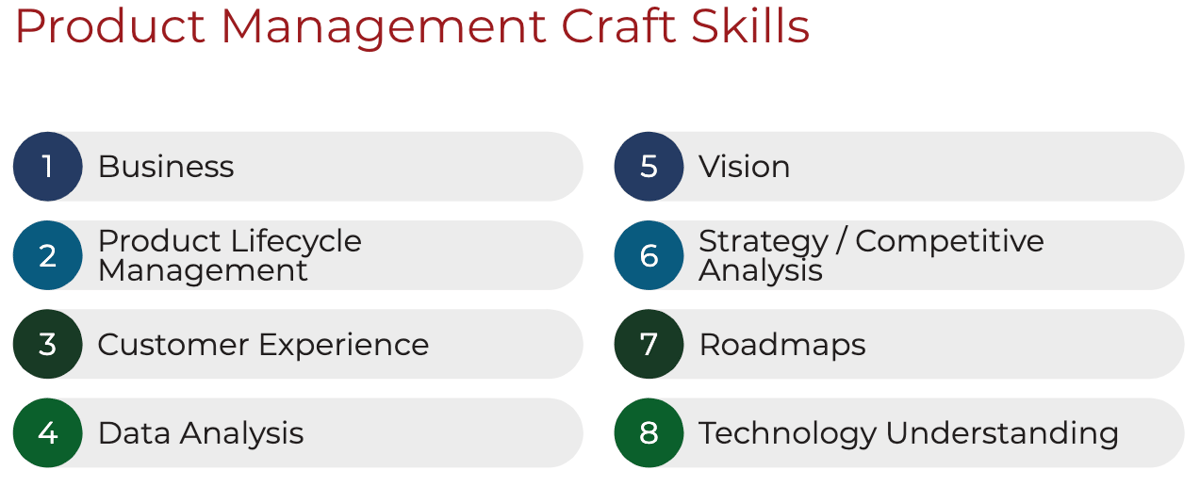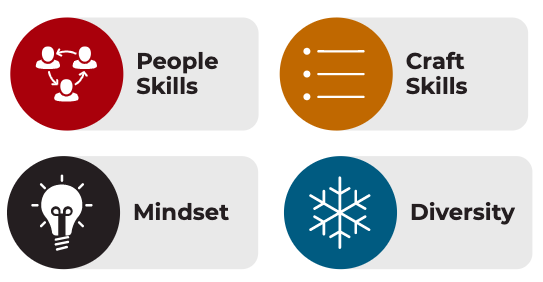Collectively, we've hired hundreds of product managers in our time. So we thought it'd be good to share the 4 big buckets of traits we look for when hiring great product managers, and explain more about each (with examples).
1. People Skills
Product management might as well be called people management, given how many relationships a product person juggles. If we looked at just the internal folks:

It's no surprise, then, that we look for these types of skills in candidates:
- Listening: getting beyond the surface level to understand people's needs and wants at a deeper level. Example: rather than just taking a feature request from a customer, asking what they're really trying to accomplish and why it's so important to them.
- Communication: making sure the right people have the right information at the right time. Example: setting the context on why a new feature is so critical to customers and the business.
- Leadership / Influence: inspiring people who don't report to you to work together towards a common vision or goal. Example: getting buy-in from engineering, design and executives on a roadmap.
- Collaboration: working together with other teams to make decisions that affect the customer experience. Example: partnering with marketing to position the product against competitors.
- Trust Building: developing rapport with internal and external stakeholders using all of these people skills. Example: getting a customer to buy into the long-term product vision rather than a discreet set of feature requests.
- People Management: building and running a team of product folks whose products and careers flourish. Example: recruiting and coaching a junior product manager who goes on to manage several successful products at the company.
- Empathy: understanding where others are coming from and using that to inform product decisions. Example: justifying a text-based feature to reach a customer segment who doesn't use smartphones.
- Emotional Intelligence: being able to read the feelings of those around you and adjust behavior accordingly. Example: realizing the audience is confused during a roadmap presentation and reframing the context to help them understand the rationale.
2. Craft Skills
Of course, there are some core product management skills to look for as well:

- Business: always thinking about the financial viability of a product. Example: preparing a business case for a new product based on the Total Addressable Market (TAM) size for an unmet need.
- Product Lifecycle Management: knowing how to launch, scale, maintain and sunset features and products. Example: conducting the market research to define the MVP for a new product, and launching it with 2 initial customers.
- Customer Experience: knowing what makes a good customer experience across all 6 chapters of the journey: trigger, discovery, evaluation, trial, usage and switching. Example: doing market research interviews to prioritize the top usability issues for a current product and addressing them to optimize freemium conversions.
- Data Analysis: identifying and tracking the most important metrics to quantify customer and shareholder value. Example: creating outcome KPI pyramids for both the business and the customer and tracking leading indicators after every release.
- Vision: articulating, validating and evangelizing a vision for where to take the product. Example: creating a customer journey vision based on market research and getting the team to buy into it.
- Strategy / Competitive Analysis: laying out options and choosing a specific path to realize the vision amidst competitive threats. Example: identifying a weakness in an existing consumer app, building a better product and then stealing customers.
- Roadmaps: creating, communicating and rationalizing a roadmap that balances between strategic progress, near-term optimizations and feature requests and product hygiene. Example: explaining why you had to say no to a non-strategic feature request from a big customer who's also eager to see strategic progress towards a vision they're excited about.
- Shipping Product: partnering with engineering and design to create processes to ship efficiently and often. Example: eliminating waterfall-like handoffs between design and engineering by having collaborative UX brainstorms to improve a product KPI
- Technology Understanding: knowing enough to understand the product and business implications of engineering's technical implementation. Example: justifying the need to switch to a micro-service architecture to support the upcoming mobile app launch.
3. Mindset
There are some characteristics that separate great product folks from good ones. It comes down to a few personality traits:
- Passion: caring about the company's mission. Example: explaining the personal story that led you to apply for a product role that's not aligned to your previous experience.
- Tenacity: sticking to it when the going gets rough (especially at a startup). Example: coming up with a game plan when engineering realizes something is going to take twice as long as they originally thought.
- Curiosity: making learning a lifelong habit, especially with product and technology. Example: reading up on machine learning algorithms in preparation for a new data scientist joining the team.
- Decisiveness: considering options and deciding to pursue one of them even with incomplete information. Example: deciding to prioritize a feature that others aren't sure about based on a market research insight.
- Problem Solving: thinking about ways to make life better for people, given a set of constraints. Example: leading a brainstorming with design and engineering to come up with a simple fix to a major usability issue customers have been complaining about.
- Responsibility: feeling personally accountable for the success of a product, regardless of the headwinds. Example: identifying 2-3 concrete ways to help out sales and marketing to ensure the product's revenue goal is hit this year
4. Diversity
There's a growing body of research that diversity can improve the performance of your team. Diversity can come in different forms:
- Gender: ensuring the top of your candidate funnel is properly balanced. Example: proactively recruiting from Women in Product to reach 50% women applicants
- Ethnicity: making sure your team has a broad representation of different cultures. Example: letting local organizations focused on diversity in technology know about your opening and asking for referrals.
- Experience: finding people with experience no one on your team already has. Example: calling out consumer product experience for your B2B2C business that's already stacked with market / customer experts.
All of these will help bring a diversity of perspective to your team that can help build better products.
Closing Thoughts
Of course, it's really easy to write all this down in a blog post. It's much harder to get it into a job description and screen candidates for these things. That's why we have a Hiring service. We'll help determine exactly who you need on your team, screen candidates for the traits we referred to above, and help with final round interviews. Whether you choose to use our service or go at it alone, just remember to think about testing a candidate's people skills, craft skills and mindset to ensure your next product person is a rockstar.


